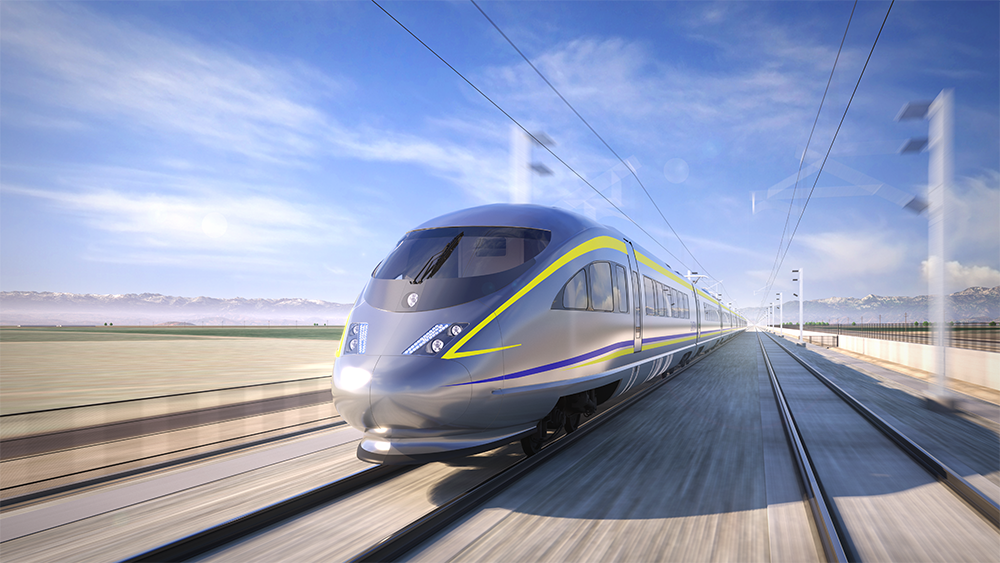Can a Railway Generate Its Own Traction Power and Become a Truly Zero-Carbon Mode of Transport?

Electrified high speed rail travel is one of the greenest ways of moving people. A journey from London to Paris by train emits merely 8kg of CO2 per passenger; compared with 122kg/passenger for air travel and 48kg/passenger for an average passenger car. Couple these figures with the fact that train travel is quicker than both other forms of transport for medium distance journeys and the case for the implementation of high-speed electrified railways become apparent. As the world increasingly looks to technology to deal with climate change, can railways use emerging Solar and Battery Energy Storage Systems (BESS) to become a true zero-carbon form of travel?
The program team on the California High Speed Rail project, a 500-mile-long high-speed rail network to join the cities of San Francisco and Los Angeles, are already searching for the answers. The rail corridor will be powered by a 25kV AC Auto-transformer traction power network, with traction power sub-stations located approximately every thirty miles. However, instead of two utility connections at each sub-station, the project is proposing to use just one, coupled with Solar and BESS systems as the second source of power. Initial studies and investigations are positive with the system taking the following architecture:
- Each Traction Power Sub-Station (TPSS) will have an adjacent solar array optimally sized to reach net-zero annually against the network load.
- Each solar array will be supplemented by a Battery Energy Storage System to aide with peak load reduction and energy offset in winter months.
- Solar and BESS is designed as the primary power source for the infrastructure with the utility connection used in periods of low sunlight or contingency situations.
- Static Frequency Converters (SFC) will allow 3-phase interconnection of the utility and Solar/BESS power supplies.
The system requires low capital expenditure compared to providing the more traditional two utility supplies and in addition to the obvious carbon saving benefits offers many system benefits, such as:
- Reduction of the California High Speed Rail Authority’s second highest operating cost, electricity, saving them tens of millions of dollars per year.
- Protection against future increases in electricity tariffs.
- Increased system resilience against black/brown outs brought on by natural disasters or extreme temperatures. The BESS infrastructure is sized to operate the system under normal service for 2 hours when disconnected from the grid. Or for longer periods under degraded operations.
- Lower capital cost expenditure on grid upgrades.
- Reduced impact on already congested power networks.
- More even load demand and a lower peak load acting on the utility network.
The thought of such a complex and far-reaching system being completely powered by solar energy may sound at the edge of innovation, but the fact is that we are simply attempting to bring two tried and tested technologies together in a new way. System integration and testing will be key to the implementation to ensure harmony and robustness under all operating conditions.
The obvious constraints for other projects implementing such a far-reaching system still exist. Usable sunlight and available landmass to name a couple, but that does not mean that projects in other parts of the world should completely discount the technology. Adding solar and storage options to railways’ overall energy mix, especially for safety critical systems, is an exciting way of offsetting carbon production and improving resilience. One example would be the use of BESS only, on a network constrained by available land such as the UK. In this case BESS can be sized to provide traction power during times of peak demand on the grid and then charged when the grid is less congested, such as at night. This reduces grid wide congestion and can reduce operating costs by giving railways access to lower tariffs, it also improves system resilience.
However, when we think about the amount of high-speed rail projects underway at the minute there are several which could make their entire traction power self-generated; NEOM in the middle east and Texas high speed rail seem obvious contenders.
In the case of the California High Speed Rail project, the argument for using solar traction power seems obvious. Whilst this will not be the case for all networks and each project will need to assess its own needs, the emerging technologies, and the ways in which we use them are creating an exciting time for traction power engineering.
Network Rail Consulting are proud to be part of the California High Speed Rail Authority’s team attempting to implement the first truly zero-carbon traction power system.
Phillip Gilmour
Associate Director, Traction Power
Network Rail Consulting Inc

